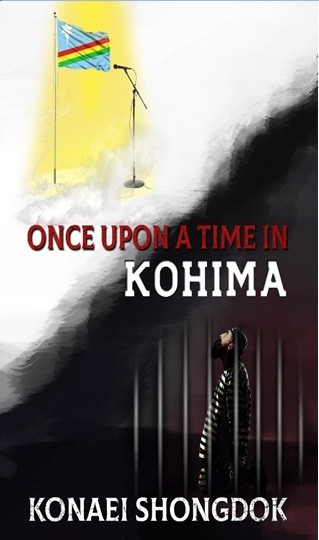
Review by Dr Neikihienuo Mepfhü-o
As a literature student, I was taught that every conflict in literature, in its simplest form, is always a struggle between good and evil. I believe that Shongdok’s book also manifest different conflicts – whether it is personal, emotional, social, economic conflict in various forms. Most of these conflicts in the book are a conflict of good versus evil.
In this book, Shongdok has presented to us parallel stories of Issa Zora Lutzo, a young writer from Noveltic State Academy, Kohima and Adrenal Ghonskod, a former convict guilty of murder. The pinnacle of the novel is the ultimate meeting of Issa and Adrenal Ghonskod. At the beginning of the book, you would understand that this meeting is purely academic as Issa sets out to write an essay titled Comical Prejudice for her final scholar year collaboration. For writing this essay, she is expected to interview Adrenal Naga, who belongs to the Underground faction Z. However, a deeper secret unravels as they ultimately meet on the peak of Japfu. As the reader goes deeper into their story, the realization dawns that they are connected to each other in a tragic way. After this revelation, the question remains as to whether Issa will be able to fulfil her mission in interviewing Ghonskod successfully or not.
The book opens with a detailed description of a church, ‘House of God’. Probably an old church with descriptions like ‘age-old clock’, ‘fading paint’, ‘rugged door’ etc. From the first chapter itself, it is a testament of the fact that literature holds up a mirror to society. Shongdok’s observation of the seating arrangement in the church – “seating allocation were classified into different rows of bamboo benches based on gender, age and status – in the ‘house of God’? Hereby, Angels and Demons too must sit accordingly.” This is an observation of the visible but undeclared status bias even in our society which permeates even further into our churches. Also, later in that chapter, he describes the sorry condition in Kohima where “streets of potholes were baked in thin layers of black toppings. Electrical connections hay-wired in pitiful points.”
As you read the novel, you will find that there are several facades that Shongdok has incorporated into his narration. There are various breaks in his narration to keep suspense especially when he is narrating his story to Aila in the Pandora express train. He also integrate actual events and places from history in his narration. He has weaved his story around these historical markers combining truth and fiction which one cannot help but think of what Mark Twain has said, “Truth is stranger than fiction.” He also included humour in his narrative technique. He uses humour as comic relief in the form of a humorous character, scene, or witty dialogue to mollify serious and tense situations. The politics of gender is also at play here. When Adrenal Ghonskod is asked to talk to Issa about his story, he is appalled to know that this supposed person is a “female student” and that too a “school girl” where to his knowledge, women were never entertained even in the headquarters’ vicinity. He also talks about the exclusion of women where “women don’t even dare to trespass or cross anywhere” near their blocks (96). He also touched briefly on the question of homosexuality and how society views it from the encounter Adrenal Ghonskod had with Aila and Htimsmas in the Pandora express train. Therefore, there are so many themes and concepts which are interwoven into the plot of the story.
This book is also a story about love but not necessarily good love. It is about damaged characters loving each other in flawed ways. Love is one of the most universal themes in literature as in life. Here, love is seen as a force for good that inspires people to sacrifice themselves for others like the life of Adrenal Ghonskod, or a toxic force that drives people to madness or violence like Dangwan, one of the associates of Adrenal Ghonskod. Along with this theme of love, it is inextricably linked to the theme of betrayal. Betrayal is a part of the human condition and human relationships and Karin Altenberg wrote that “the kind of fanatic strength derived from love, or blind faith, may also lead to betrayal.” In this book, the “blind faith” that Adrenal Naga had on the stranger led him to his fall and it was not only the stranger who betrayed him but his own blind faith has also betrayed him. In the case of Issa, it was Dangwan’s fanatic love which ultimately violated and betrayed her. Therefore, like the parallel connection between the lives of Adrenal Ghonskod and Issa, the concept of love and betrayal also features simultaneously in this novel.
Something which cannot be ignored while telling a Naga story is the world of the Naga political organizations or Naga political groups. Here, Shongdok has given us a glimpse of the Naga political organization through the life of Adrenal Ghonskod who is said to belong to the faction Z. The main objective of these Naga political groups is to establish a sovereign Naga state which is declared by Adrenal Naga – “From the age of thirteen I’ve been defending my land in the underworld…my native is home to numerous underground factions” (60). He also patriotically told Issa that even “enemy or family who stand against my parade to freedom will be slayed. Be it Nagas, dwarves, or Nephilims” (113). However, beneath this air of patriotism, there is also the undeniable turmoil, personal, political and otherwise which can be seen through the lives of Adrenal Naga and his associates – Ananias, Dangwan, and Motom and also in their relationship with each other. The Indian novelist Shashi Deshpande wrote that the success of young writers today is because of the reason that “they live in the society they are writing about.” I believe Shongdok has this to his advantage as well as he navigates through the life of Issa and Adrenal Ghonskod. It is obvious that he would relate to the life of Issa as a student as he could integrate his own experience as well, however, for him to write about Adrenal Ghonskod and his story vividly would be because he is also indirectly living through these experiences as he writes.
As much as this is a story about betrayal, destructive love, turmoil, and conflict, this novel is also a story about justice, forgiveness, and reconciliation. Adrenal Ghonskod delivers justice to Issa as he assures her, “I am here to represent the law. Justice to you” (225). It is ironic that the Adrenal Ghonskod is the one who delivers justice to Issa as she is also related to his imprisonment. There is also the revelation that all the characters in the novel are both “victims and abusers” (225). Issa got what she was looking – her story, justice and forgiveness, but she had to pay a heavy price for it. For both Issa and Adrenal Ghonskod, as they walk away from Japfü, they had no choice but to reconcile with each other, forgive each other, others, and themselves, and only then, it will lead them to their real freedom. This scene is reminiscent of what Nelson Mandela had said after he was unjustly imprisoned by the South African Apartheid government for 27 years. “As I walked out the door toward the gate that would lead to my freedom, I knew if I didn’t leave my bitterness and hatred behind, I’d still be in prison.” Therefore, what began as a story of conflict and turmoil became a story of healing and reconciliation for the two main characters Issa and Adrenal Ghonskod in the end.
David Foster Wallace has said that good literature is supposed to comfort the disturbed and disturb the comfortable. I hope Shongdok’s book ‘Once Upon a time in Kohima’ comfort or disturb you – in making an impact on you in one way or the other. I congratulate Konaei Shongdok and also Heritage Publishing House for this publication.
Contact the author: Konaei Shongdok-(7085812296) or konaeikonaei@gmail.com
Novel available at: Crossword, The Common Room, Made in Nagaland, Pages, D' Café, Ete Coffee, Ozone Café, The Benjamins, Heritage Publishing House and www.ilandlo.com






